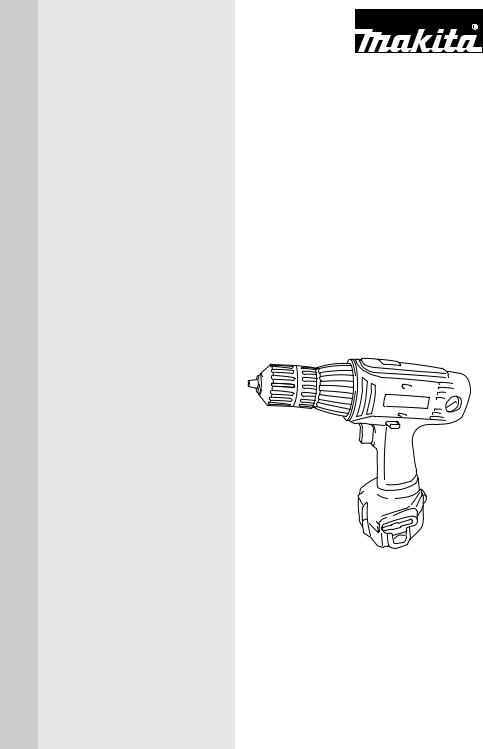Makita 6213D User Manual

Cordless Driver Drill
Equipped with Electric Brake
MODEL 6213D
I N S T R U C T I O N M A N U A L
 WARNING:
WARNING:
For your personal safety, READ and UNDERSTAND before using. SAVE THESE INSTRUCTIONS FOR FUTURE REFERENCE.
w w w . m a k i t a t o o l s . c o m

SPECIFICATIONS
|
Model |
|
|
6213D |
|
|||
|
|
|
|
|
|
|
|
|
|
|
Steel |
|
|
10 mm (3/8”) |
|
||
|
|
|
|
|
|
|
|
|
Capacities |
|
Wood |
|
|
25 mm (1”) |
|
||
|
|
|
|
|
|
|
|
|
|
Wood screw |
|
6.4 x 76 mm (1/4” x 3”) |
|||||
|
|
|
||||||
|
|
|
|
|
|
|
|
|
|
|
Machine screw |
|
6 mm (1/4”) |
|
|||
|
|
|
|
|
|
|
|
|
No load speed (RPM) |
High |
|
|
0 - 1,400/min. |
|
|||
|
|
|
|
|
|
|
||
Low |
|
|
0 - 450/min. |
|
||||
|
|
|
|
|
||||
|
|
|
|
|
|
|
|
|
Dimensions (L x W x H) |
|
|
233 mm x 94 mm x 241 mm |
|||||
|
|
(9-1/8” x 3-11/16” x 9-1/2”) |
||||||
|
|
|
|
|
|
|||
|
|
|
|
|
|
|
|
|
|
Net weight |
|
|
1.9 kg (4.2 lbs) |
|
|||
|
|
|
|
|
|
|
|
|
|
|
|
|
|
|
|
|
|
Battery Charger |
|
|
|
|
DC1413 |
|
||
|
|
|
|
|
|
|||
Input |
|
|
|
A. C. only 50 Hz - 60 Hz |
|
|||
|
|
|
|
|
|
|||
Output |
|
|
|
D. C. 7.2 V - 14.4 V |
|
|||
|
|
|
|
|
|
|
|
|
Battery Cartridge |
1222 |
|
1233 |
|
1234 |
|
1235 |
|
|
|
|
|
|
|
|
|
|
Voltage |
|
|
|
|
12 V |
|
||
|
|
|
|
|
|
|
||
Charging time |
45 min. |
|
50 min. |
|
60 min. |
|
70 min. |
|
|
|
|
|
|
|
|
|
|
•Manufacturer reserves the right to change specifications without notice.
•Specifications may differ from country to country.
GENERAL SAFETY RULES |
USA003-1 |
(FOR All BATTERY OPERATED TOOLS)
 WARNING:
WARNING:
Read and understand all instructions. Failure to follow all instructions listed below, may result in electric shock, fire and/or serious personal injury.
SAVE THESE INSTRUCTIONS
2

Work Area
1.Keep your work area clean and well lit.
Cluttered benches and dark areas invite accidents.
2.Do not operate power tools in explosive atmospheres, such as in the presence of flammable liquids, gases, or dust. Power tools create sparks which may ignite the dust or fumes.
3.Keep bystanders, children, and visitors away while operating a power tool. Distractions can cause you to lose control.
Electrical Safety
4.A battery operated tool with integral batteries or a separate battery pack must be recharged only with the specified charger for the battery. A charger that may be suitable for one type of battery may create a risk of fire when used with another battery.
5.Use battery operated tool only with specifically designated battery pack. Use of any other batteries may create a risk of fire.
Personal Safety
6.Stay alert, watch what you are doing, and use common sense when operating a power tool. Do not use tool while tired or under the influence of drugs, alcohol, or medication. A moment of inattention while operating power tools may result in serious personal injury.
7.Dress properly. Do not wear loose clothing or jewelry. Contain long hair. Keep your hair, clothing, and gloves away from moving parts. Loose clothes, jewelry, or long hair can be caught in moving parts.
8.Avoid accidental starting. Be sure switch is in the locked or off position before inserting battery pack. Carrying tools with your finger on the switch or inserting the battery pack into a tool with the switch on invites accidents.
9.Remove adjusting keys or wrenches before turning the tool on. A wrench or a key that is left attached to a rotating part of the tool may result in personal injury.
10.Do not overreach. Keep proper footing and balance at all times. Proper footing and balance enable better control of the tool in unexpected situations.
11.Use safety equipment. Always wear eye protection. Dust mask, non-skid safety shoes, hard hat, or hearing protection must be used for appropriate conditions.
Tool Use and Care
12.Use clamps or other practical way to secure and support the workpiece to a stable platform. Holding the work by hand or against your body is unstable and may lead to loss of control.
13.Do not force tool. Use the correct tool for your application. The correct tool will do the job better and safer at the rate for which it is designed.
14.Do not use tool if switch does not turn it on or off. A tool that cannot be controlled with the switch is dangerous and must be repaired.
15.Disconnect battery pack from tool or place the switch in the locked or off position before making any adjustments, changing accessories, or storing the tool.
Such preventive safety measures reduce the risk of starting the tool accidentally.
16.Store idle tools out of reach of children and other untrained persons. Tools are dangerous in the hands of untrained users.
17.When battery pack is not in use, keep it away from other metal objects like: paper clips, coins, keys, nails, screws, or other small metal objects that can make a connection from one terminal to another.
Shorting the battery terminals together may cause sparks, burns, or a fire.
3

18.Maintain tools with care. Keep cutting tools sharp and clean. Properly maintained tools with sharp cutting edge are less likely to bind and are easier to control.
19.Check for misalignment or binding of moving parts, breakage of parts, and any other condition that may affect the tool’s operation. If damaged, have the tool serviced before using. Many accidents are caused by poorly maintained tools.
20.Use only accessories that are recommended by the manufacturer for your model. Accessories that may be suitable for
one tool may create a risk of injury when used on another tool.
SERVICE
21.Tool service must be performed only by qualified repair personnel. Service or maintenance performed by unqualified personnel may result in a risk of injury.
22.When servicing a tool, use only identical replacement parts. Follow instructions in the Maintenance section of this manual.
Use of unauthorized parts or failure to follow Maintenance instructions may create a risk of shock or injury.
SPECIFIC SAFETY RULES |
USB022-2 |
DO NOT let comfort or familiarity with product (gained from repeated use) replace strict adherence to cordless drill safety rules. If you use this tool unsafely or incorrectly, you can suffer serious personal injury.
1.Hold tool by insulated gripping surfaces when performing an operation where the cutting tool may contact hidden wiring.
Contact with a “live” wire will also make exposed metal parts of the tool “live” and shock the operator.
2.Be aware that this tool is always in an operating condition, because it does not have to be plugged into an electrical outlet.
3.Always be sure you have a firm footing.
4.Be sure no one is below when using the tool in high locations.
5.Hold the tool firmly.
6.Keep hands away from rotating parts.
7.Do not leave the tool running. Operate the tool only when hand-held.
8.Do not touch the drill bit or the workpiece immediately after operation; they may be extremely hot and could burn your skin.
9.Some material contains chemicals which may be toxic. Take caution to prevent working dust inhalation and skin contact. Follow material supplier safety data.
4

SAVE THESE INSTRUCTIONS
 WARNING:
WARNING:
MISUSE or failure to follow the safety rules stated in this instruction manual may cause serious personal injury.
SYMBOLS |
USD301-1 |
The followings show the symbols used for tool.
V |
volts |
n˚ |
no load speed |
.................... |
|||
|
direct current |
.../min |
revolutions or reciprocation per |
|
|||
|
|
|
minute |
IMPORTANT SAFETY INSTRUCTIONS FOR
CHARGER & BATTERY CARTRIDGE |
USC001-3 |
1.SAVE THESE INSTRUCTIONS - This manual contains important safety and operating instructions for battery charger.
2.Before using battery charger, read all instructions and cautionary markings on
(1)battery charger, (2) battery, and (3) product using battery.
3.CAUTION - To reduce risk of injury, charge only MAKITA rechargeable batteries marked on the charger label. Other types of batteries may burst causing personal injury and damage.
4.Do not expose charger to rain or snow.
5.Use of an attachment not recommended or sold by the battery charger manufacturer may result in a risk of fire, electric shock, or injury to persons.
6.To reduce risk of damage to electric plug and cord, pull by plug rather than cord when disconnecting charger.
7.Make sure cord is located so that it will not be stepped on, tripped over, or otherwise subjected to damage or stress.
8.An extension cord should not be used unless absolutely necessary. Use of improper extension cord could result in a risk of fire and electric shock. If extension cord must be used, make sure:
a.That pins on plug of extension cord are the same number, size, and shape as those of plug on charger;
b.That extension cord is properly wired and in good electrical condition;
5

c.That wire size is at least as large as the one specified in the table below.
Table 1: RECOMMENDED MINIMUM AWG SIZE FOR EXTENSION CORDS FOR BATTERY CHARGERS
Length of Cord (Feet) |
25 |
50 |
100 |
150 |
|
|
|
|
|
AWG Size of Cord |
18 |
18 |
18 |
16 |
|
|
|
|
|
9.Do not operate charger with damaged cord or plug - replace them immediately.
10.Do not operate charger if it has received a sharp blow, been dropped, or otherwise damaged in any way; take it to a qualified serviceman.
11.Do not disassemble charger or battery cartridge; take it to a qualified serviceman when service or repair is required, Incorrect reassembly may result in a risk of electric shock or fire.
12.To reduce risk of electric shock, unplug charger from outlet before attempting any maintenance or cleaning. Turning off controls will not reduce this risk.
13.The battery charger is not intended for use by young children or infirm persons without supervision.
14.Young children should be supervised to ensure that they do not play with the battery charger.
15.If operating time has become excessively shorter, stop operating immediately. It may result in a risk of overheating, possible burns and even an explosion.
16.If electrolyte gets into your eyes, rinse them out with clear water and seek medical attention right away. It may result in loss of your eyesight.
ADDITIONAL SAFETY RULES FOR CHARGER &
BATTERY CARTRIDGE
1.Do not charge Battery Cartridge when temperature is BELOW 10°C (50°F) or ABOVE 40°C (104°F).
2.Do not attempt to use a step-up transformer, an engine generator or DC power receptacle.
3.Do not allow anything to cover or clog the charger vents.
4.Always cover the battery terminals with the battery cover when the battery cartridge is not used.
5.Do not short the battery cartridge:
(1)Do not touch the terminals with any conductive material.
(2)Avoid storing battery cartridge in a container with other metal objects such as nails, coins, etc.
(3)Do not expose battery cartridge to water or rain.
A battery short can cause a large current flow, overheating, possible burns and even a breakdown.
6.Do not store the tool and Battery Cartridge in locations where the temperature may reach or exceed 50°C (122°F).
6
